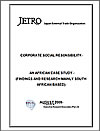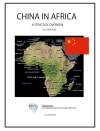 Holcim Group
Holcim Group
All data are collected in the Fiscal Year of 2008-2009.
Company Profile and History
Holcim is one of the world’s leading suppliers of cement and aggregates (crushed stone, sand and gravel). Holcim initiated production of cement in 1912 in the village of Holderbank, (Lenzburg district, Canton of Aargau, ca. 40 km from Zürich) and used the name Holderbank AG until 2001. It is currently the second largest cement manufacturer in the world, behind Lafarge. Holcim is employs some 80,000 people, with production sites in around 70 countries.
By the early 1920s, the company began investing in cement businesses in other European countries. This trend was quickly followed by investments in Egypt, Lebanon and South Africa. In the years following 1945, and particularly in the 1950s and 1960s, a network of holdings began to develop in North and Latin America; in the 1970s, Holcim began to explore ventures in the emerging markets of the Asia-Pacific region; in the 1980s, Holcim continued to expand into new markets, including Eastern Europe. A greater focus on aggregates and ready-mixed concrete production strengthened the company’s position as a vertically integrated market leader; and a strong focus on core business activities in cement, concrete and aggregates characterized Holcim’s activities during the 1990s.
The name of the Group was changed from "Holderbank" Financière Glaris Ltd. to Holcim Ltd in May 2001.
The Holcim Group (Overseas) began its history in the steel industry in 1704 when Jean Martin Wendel launched a group in Lorraine, France that bore his name. This company eventually became Macoma/Macor which in 1950 established Macoma in Madagascar, specifically in Antananarivo and Tamatave. Macoma constructed the cement plant at Ibity in the late 1960s. Also in the late 1960s BCR (Concrete Reunion), Origny-Desvroise and Ciments de Bourbon started their cement businesses in Madagascar. In 1981 BCR took control of Macoma, Macor and Ciments de Bourbon; in 1987 Macoma became a subsidiary of Macor; and in 1994 Macor joins Holderbank and in 1995 Origny-Desvroise became a 100 percent subsidiary of Holderbank.
On 01 July 2002, the group became Macor Holcim (Réunion) SA and Macoma became Holcim (Madagascar) S.A. The company in Madagascar has two production centres: an integrated plant with a capacity of producing 150 000 tonnes/year in Antsirabe (Ibity) and a silo with a capacity of 180 000 tonnes/year located in Tamatave.
Holcim had been named “Leader of the Industry” in the Dow Jones Sustainability Index from 2005 to 2008 and was thus acknowledged as the company with the best sustainability performance in the building materials industry for four consecutive year
In Country Location
Z.I. no 1 - rue Armagnac, BP 73, RE-97822, Le Port, Réunion; Phone +262 262 42 58 20; Fax +262 262 42 58 21
Services and Products
Holcim’s core businesses include the manufacture and distribution of cement, and the production, processing and distribution of aggregates (crushed stone, gravel and sand), ready-mix concrete and asphalt. The company also offers consulting, research, trading, and engineering services.
Number of Employees
620 employees in Madagascar
Financial Information
Company Statistics
| 2008 | 2007 | 2006 | |
|---|---|---|---|
| Net sales | 25,157 | 27,052 | 23,969 |
| Gross profit | 11,041 | 12,979 | 11,353 |
| Operating EBITDA | 5,333 | 6,930 | 6,086 |
| Operating EBITDA margin | 21.2% | 25.6% | 25.4% |
| EBITDA | 5,708 | 8,468 | 6,333 |
| Operating profit | 3,360 | 5,024 | 4,385 |
| Operating profit margin | 13.4% | 18.6% | 18.3% |
| Cash flow from operating activities | 3,703 | 5,323 | 4,423 |
| Cash flow margin | 14.7% | 19.7% | 18.5% |
| Current assets | 9,994 | 10,372 | 9,747 |
| Long-term assets | 35,199 | 37,839 | 34,955 |
| Total assets | 45,193 | 48,211 | 44,702 |
| Short-term liabilities | 10,765 | 9,025 | 8,621 |
| Long-term liabilities | 16,454 | 17,241 | 17,356 |
| Annual production capacity cement (Million t) | 194.4 | 197.8 | 197.8 |
| Sales of cement (Million t) | 143.4 | 149.6 | 140.7 |
| Sales of mineral components (Million t) | 4.8 | 5.5 | 6.0 |
| Sales of aggregates (Million t) | 167.7 | 187.9 | 187.6 |
| Sales of ready-mix concrete (Million m) | 48.5 | 45.2 | 44.2 |
Regional Sales
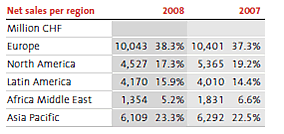
In 2007, the company produced 160,000 t at its Toamasina plant and 110,000 t at its Ibity plant. Sales and production figures for 2008/09 not available
Market Share
In 2007 Holcim (Madagascar) S.A. was Madagascar’s only cement producer (Lafarge’s plant did not operate in 2007). Holcim also has the only clinker manufacturing site in Madagascar. Holcim has an 80 percent market share in Madagascar and Lafarge 10 percent, while various other smaller companies together hold the other 10 percent.
In 2008 Chine Shuguang Maloci of China started operations in Madagascar-it is not yet clear the percentage it would take.
Business Objective
“To be the world’s most respected and attractive company in our industry -creating value for all our stakeholders”
Business Model
Aiming to keep a balanced portfolio, Holcim’s business strategy is based on continuous growth in both developed economies and emerging, high-growth markets, where around three-quarters of our operational capacity, accounting for almost half of the Group’s net sales, is based.
Holcim explains its business model as follows:
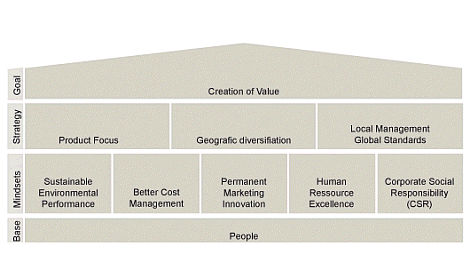
Innovative, application-driven, high-quality products make us the provider of first choice. Among the reasons for Holcim's lasting success is a product strategy with a focus on the production and distribution of our core products - cement and aggregates - both which are key basic materials for construction:
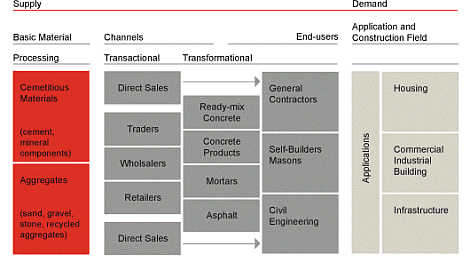
The main focus of investment is the processing of raw materials. The production of cement and aggregates, for example, requires a great deal of process know-how, and is a highly capital-intensive process that ties up assets over the long term. Because of the continuing demand for new production facilities and rising building costs, capital expenditures for cement production have risen substantially.
However, our investment policy and product range are adapted to suit the maturity of each market and local customer needs. So while cement and aggregates are the basis of our business, other products bring us closer to the end-consumer. As markets mature and customer needs broaden, we offer ready-mix concrete, concrete goods, asphalt and associated services. In emerging markets, we focus on building up and expanding cement production; in maturing economies, vertical integration becomes more significant, and we aim to establish ready-mix concrete businesses in major urban centres; and in developed markets, the range of products is even more diversified and includes aggregates, asphalt and concrete products. Because of the high degree of regulation in industrialized nations, it is strategically important to have high-grade, secure raw material reserves.
Cement – market positioning to capture growth
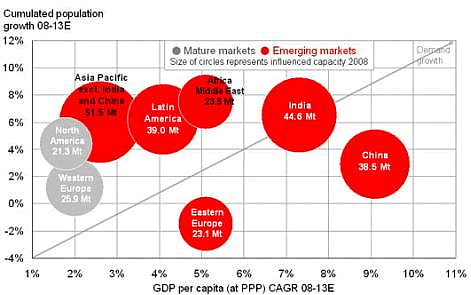
Aggregates-counterweight in mature markets
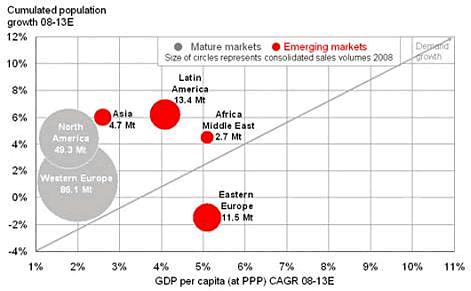
Our business has local roots and is geared to the conditions and needs of each specific market where we operate, yet we have Group-wide standards and systematic benchmarking that allow us to enhance our efficiency. Therefore, our success lies in striking a balance between local responsibility and global leadership.
The extraction of large quantities of raw materials, the operation of capital-intensive cement plants and the distribution of building materials to local or regional markets requires strong local presence and an awareness of our responsibilities. However, to fully exploit our potential, Holcim has standardized all its major corporate processes. This allows local management to concentrate on market development, cost efficiencies, training for staff and senior managers, and nurturing community relations at a local level.
Ownership of Business
Share interests of Board of Directors and senior management: As of December 31, 2008, the members of the Board of Directors and the senior management of Holcim held directly and indirectly in the aggregate 54,685,328 (2007: 54,109,159) registered shares and no rights to acquire further registered shares and 630,003 (2007: 570,101) call options on registered shares.
Important shareholders: As of July 17, 2009, Thomas Schmidheiny directly and indirectly held 59,493,558 or 18.19 percent (2008: 54,292,690 or 20.60 percent), (2007: 53,741,950 or 20.39 percent) registered shares; Capital Group Companies Inc. held 13,181,456 or 5 percent shares as of August 15, 2008, and Eurocement Holding AG held 17,187,000 or 6.52 percent shares as of September 19, 2008.
Free float: As per December 31, 2008 the free float as defined by the SIX Swiss Exchange stands at 79 percent.
In Madagascar Holcim Overseas Group holds a 90 percent share in Holcim (Outre-Mer) S.A.S.
Benefits Offered and Relations with Government
Madagascar's current policy is mainly aimed at monitoring the prices of basic necessities (PPN), namely, edible oils, condensed milk, baby food, cement, flour, bread, sugar, household soap, school exercise books, candles, packaging products. These are defined within the historical context of the price control policy followed by the authorities up to 1987 when the regime was first liberalized.
Despite tax and customs incentives they have been given, Madagascar's manufacturers complain, inter alia, of the recurrent electricity supply problems, the high cost of access to financing, lack of transport services and telecommunications, macroeconomic instability and poor governance.
Product Development
In 2009 Holcim increased prices by 7.5 percent due to the depreciation of the Ariary (currency that Holcim uses to import its raw materials), which has lost 25 percent of its value relative to the dollar; anthracite, used in the manufacture of cement, has increased in price since last year; and the cost of electricity has gone up since November 2008.
The political crisis in Madagascar has severely affected the demand for cement. In order to address the problem, Holcim announced in 2009 that it would add lime to the cement to improve its characteristics. It also introduced a new product: an asphalt binder used in the treatment and stabilization of soil, to improve paved and dirt roads.


